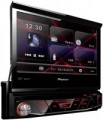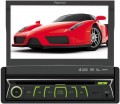Media types
Media types supported by the car radio.
— CDs. Support for optical discs usually assumes at least
compatibility with CD, the ability to work
with DVD is somewhat less common . For more information about these types, see "Disk Types". Here we note that nowadays, disks are gradually being replaced by more compact and functional media — in particular, memory cards and USB devices; so many modern radio tape recorders, including high-end ones, do
not have optical drives at all.
—
Memory cards. Ability to work with removable memory cards, usually SD or microSD; the module for reading them is called a card reader. This feature is convenient primarily because such cards are supported by many other devices — in particular, laptops and photo / video cameras. The card reader facilitates the exchange of data between these devices: for example, a selection of music from a laptop can be written to a memory card. Note that the specific type of supported cards needs to be specified separately — the (micro)SD format includes several varieties that are not quite compatible with each other.
—
USB drive (front). The ability of the radio to work with external USB-drives — "
flash drives ",
hard drives,
MP3 players, etc. — to pla
...y content directly from them. In this case, it means connecting such media to the USB connector located on the front panel of the radio — it is convenient because the connector is in close proximity, right at hand.
— USB drive (rear). Connecting USB drives (see above) through the rear panel. However, the external device is connected not directly to the rear panel, but to an external USB connector, which, in turn, is connected to the rear panel with a cable. Such a connector does not take up space on the front panel, but you can place it on a shelf under the dashboard — and the connected drive will not stick out of the radio, but lie neatly on the shelf. But in standard radios (see above), the “rear” connection can be carried out a little differently — there the cable from the rear panel can be connected to the standard USB socket on the instrument panel using a special connector.
— Connecting an iPod/iPhone. The ability to connect portable devices from Apple to the radio — primarily iPods and iPhone smartphones — through a special docking connector. Even the simplest options for such a connection, in addition to playing music, provide a number of additional features — in particular, control of the player's functions (for example, switching a track) from the control panel or remote control of the radio itself. And the most advanced models have a proprietary CarPlay system; for more information about it, see "Control functions".
— Android connection. The ability to connect smartphones and other devices based on the Android operating system to the radio. Connection methods may vary: for example, some radio models support only a wired connection, others can use Bluetooth (see "Multimedia"). The same applies to the set of functions available in each case, this point should be clarified according to the manufacturer's official data. Specific features include direct playback of music from the phone (with control through the radio), working with the contents of its drive, watching videos, using the radio as a car kit for receiving calls, etc. And in high-end models, there is support for Android Auto smartphone integration technology; for more information about it, see "Control functions".Number of bands
The number of bands in the radio equalizer.
In this case, the band means a separate part of the frequency range, the volume of which can be adjusted using the equalizer independently of the other parts. The more bands the equalizer has, the more accurately it allows you to adjust the overall sound of the car radio acoustics. However, note that multi-band equalizers are quite difficult to set up, therefore they are recommended primarily for experienced users.
Number of fixed settings
The number of fixed settings (presets) provided in the car radio equalizer.
The presence of such settings can greatly simplify the adjustment: choosing the right preset is easier than manually adjusting each EQ band. At the same time, presets are often selected by the manufacturer for certain genres of music and have the appropriate names — "Rock", "Pop", "Jazz", etc.; this simplifies the task even more. And the more fixed settings in the device, the wider the choice of the user. In some radio tape recorders, in addition to pre-flashed ones, user presets are also provided — they can be programmed in advance and turned on in the same way as the preset ones.
High Pass Filter (HPF)
The ability to adjust the high cut without affecting other frequency ranges. Thanks to this, you can improve the overall timbre of the sound by completely removing the high frequencies, if necessary (for example, for a subwoofer). Moreover, this method of adjustment is much simpler than adjusting individual equalizer bands (see above). Typically, this function is combined with bass control (see below).
Low Pass Filter (LPF)
The ability to adjust the low cut without affecting other frequency ranges. Thanks to this, you can completely remove low frequencies (for example, for salon acoustics, when the subwoofer is “responsible” for the bass), without affecting other frequencies. This way of adjusting is much easier than adjusting individual EQ bands (see above).
Power per channel
The rated sound power produced by the radio amplifier for each audio channel.
Nominal is the highest average (rms) sound power at which the amplifier operates without overload and is able to operate for an unlimited time. This is the main indicator characterizing the overall sound volume of the radio; individual power surges can be much higher than the nominal value, but they are short-lived; here we are talking about a constant signal level. In addition, compatibility with specific speakers depends on this indicator: the rated power of the speaker system must be no lower than that of the amplifier, otherwise the speakers may be damaged at high volumes. However, the spread is not so great; there are radios with an output power of
40 W,
45 W,
50 W,
55 W,
60 W and more.
Optimal amplifier power settings depend on a number of factors, ranging from the number of channels to the personal preferences of listeners. Detailed information on this topic can be found in special sources; In short, we can say that the higher the power per channel, the louder the sound the radio can produce.
Line out
The number of line outputs (see above) provided in the design of the radio. It should be noted that usually these outputs use RCA connectors (“tulip”), and the analog format allows only one audio channel to be transmitted through one such. Therefore, to work with a stereo signal,
two RCA connectors are required, and just a pair of such jacks is considered to be one line output - a set designed for one set of stereo speakers. The main difference between this interface and the same RCA used to connect speakers (see above) is that the line output receives a signal from a preamplifier that is unsuitable for feeding to passive acoustics. Such a signal must be sent to active speakers or an external amplifier (whereas the speaker is connected to the output of a power amplifier designed for passive speakers).
Video output (composite)
The number of
composite video outputs provided in the stereo design.
The "full-size" composite interface includes 3 RCA ("tulip") jacks—one for video signal and one each for the left and right stereo channels. However, in stereo systems, other outputs are used to transmit audio signals, so in this case, we only refer to video output—it's usually characterized by a distinctive yellow color. The video signal via the composite interface is transmitted in analog format, resulting in average quality with relatively low interference resistance. At the same time, these capabilities are more than sufficient for connecting most car screens, such as monitors built into the backs of front seats. And several composite outputs allow for connecting the corresponding number of screens simultaneously without using additional equipment (splitters).
Subwoofer output
A separate output for connecting a low-frequency speaker — a subwoofer. Ordinary speakers tend to have low quality bass reproduction; a subwoofer is used to “overlap” this range, as a result, the sound becomes much more powerful and rich. However, connecting to a regular audio output would require the use of frequency filters — so that only low frequencies enter the subwoofer. A separate
output for the subwoofer eliminates the need for such devices — this connector is already filtered signal. However note that usually this interface is designed to connect an active subwoofer; passive will need a separate amplifier.

